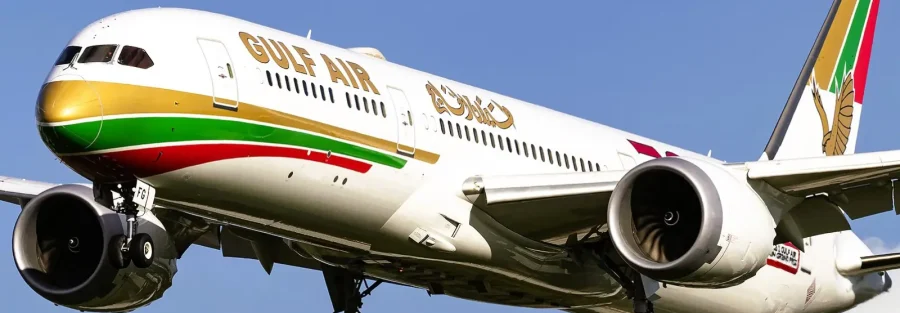When Gulf Air’s Boeing 787-9 touched down at New York’s JFK Airport in September 2025, it wasn’t just the arrival of another flight – it was the return of Bahrain to one of the world’s most competitive aviation corridors.
After nearly three decades, the Kingdom’s national carrier has relaunched non-stop flights between Manama and New York, reconnecting the Gulf’s smallest aviation hub with one of the largest global gateways. The move is both symbolic and strategic – a reflection of Bahrain’s quiet confidence and its renewed ambition to reclaim visibility on the global aviation map.
More Than a Route – A Statement of Intent
For Gulf Air, this is not merely about reopening a long-abandoned route. It’s a statement that Bahrain is once again ready to compete, connect, and collaborate on a global scale.
The airline is deploying its Dreamliner 787-9 fleet – known for fuel efficiency and long-haul comfort – on the route, signaling both environmental awareness and commercial intent. The flight connects Bahrain to New York three times weekly, complementing the airline’s existing network across Europe, Asia, and the Gulf.
This comeback fits squarely into the national goal of positioning Bahrain as a strategic connector between East and West, aligning with the Kingdom’s Economic Vision 2030, which emphasises diversification, tourism growth, and international partnerships.
The Soft Power Behind the Takeoff
National airlines have always been more than transporters – they are brand ambassadors. Gulf Air’s return to New York represents Bahrain’s growing soft power and renewed global presence.
At a time when the Middle East’s aviation giants – Emirates, Qatar Airways, and Saudia – dominate long-haul traffic, Gulf Air’s move is bold but deliberate. Instead of competing on volume, Bahrain is competing on experience, precision, and partnership.
The new route also supports diplomatic and economic outreach. With Bahraini investments in the U.S. growing steadily, and American businesses expanding in the Gulf, this direct connection reaffirms the strength of bilateral ties between Manama and Washington.
Fuel for Tourism and Trade
Direct connectivity changes economies. According to IATA, every long-haul route contributes hundreds of millions of dollars in economic output through tourism, trade, and investment.
For Bahrain, the New York service is expected to stimulate both inbound tourism and outbound business travel. U.S. travelers now have a direct route into Bahrain’s emerging tourism market – from the Pearling Path in Muharraq to the Formula 1 Grand Prix and Manama’s new waterfront developments.
At the same time, Bahraini business leaders, investors, and students gain faster, easier access to North America. The route also positions Bahrain as a convenient hub for Gulf travelers heading west, strengthening its position in the region’s aviation ecosystem.
Why Now?
The timing of Gulf Air’s U.S. return is no coincidence. Over the past five years, Bahrain’s aviation infrastructure has undergone a transformation. The new Bahrain International Airport terminal, opened in 2021, boosted capacity to 14 million passengers per year and introduced next-generation passenger experience standards.
Meanwhile, Gulf Air has quietly modernised its fleet and redefined its brand around “boutique excellence” – smaller in scale, but focused on personalisation and quality.
In the words of Gulf Air Group Chairman Zayed R. Alzayani, the airline’s strategy is about “delivering a world-class experience with a distinctly Bahraini identity.” The New York route puts that philosophy to the test – and the world’s eyes back on Bahrain.
A New Chapter in Competition
Still, the skies are crowded. Gulf Air is entering a route dominated by global heavyweights: Emirates via Dubai, Qatar Airways via Doha, and Etihad via Abu Dhabi. But its competitive edge lies in niche positioning – offering direct, boutique service and shorter flight times for passengers who value efficiency over connection chains.
Industry analysts also note the rise of premium leisure travel, a segment Gulf Air is targeting aggressively. The airline’s new Falcon Gold cabins, digital booking upgrades, and loyalty partnerships are built to capture exactly that market.
In a post-pandemic travel world, travelers are choosing airlines not just for price, but for reliability and authenticity – both areas where Gulf Air’s reputation remains strong.
Economic Ripple Effects
The ripple effects of this move extend beyond aviation. Increased passenger flow means higher hotel occupancy, new tourism investments, and a stronger case for Bahrain as a regional business hub.
The Bahrain Economic Development Board (EDB) projects that tourism’s contribution to GDP will rise by 11% annually through 2028, driven by better air connectivity and new destination branding. Gulf Air’s long-haul routes play a critical role in that strategy.
A Small Nation with Big Ambition
For Bahrain, success has never been about size – it’s about consistency and clarity of purpose. The return to New York shows that the Kingdom can balance ambition with prudence: expanding globally while maintaining its identity.
The move signals confidence not just in Gulf Air, but in Bahrain’s broader economic story – one that’s powered by diversification, resilience, and quiet determination.
Conclusion
Gulf Air’s return to New York is more than a flight; it’s a milestone in Bahrain’s modern narrative. It embodies national pride, economic foresight, and the belief that connectivity is power.
After 28 years, Bahrain isn’t just back on the transatlantic map – it’s flying there on its own terms.





